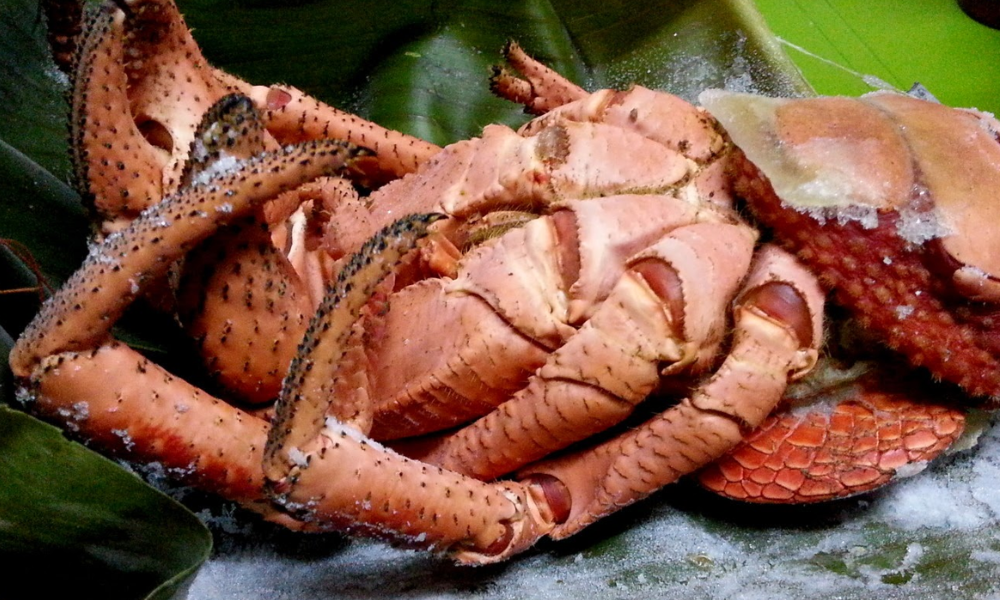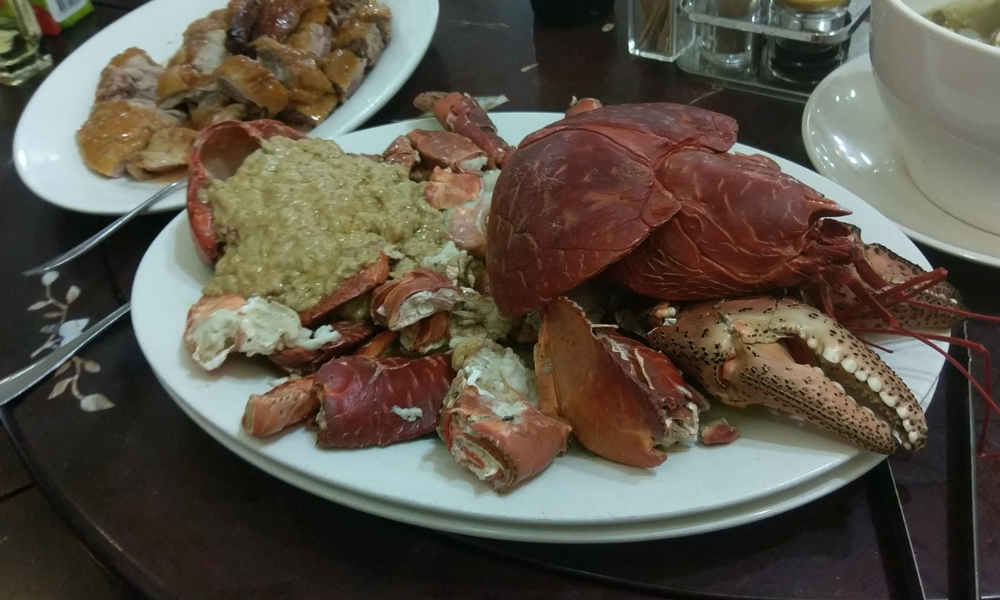Can you eat coconut crabs? is the most common query. But before you give it a go, there are a few things to bear in mind. Crabs from coconuts are quite deadly. Their strong pincers have the ability to enclose humans, fracture their bones, and even consume corpses.
The coconut crab is edible since it is prized as a delicacy in many nations. In fact, it is currently an endangered species since so many people eat it. Sadly, this doesn’t stop people from killing them for their meat, since they can still be found on many menus on islands in the central Pacific Ocean and the Indian Ocean.
On several islands, the coconut crab is a delicacy that is also thought to be an aphrodisiac, and there have been certain regions where the species’ survival has been threatened by excessive hunting. Although the coconut crab is not naturally dangerous, depending on its diet, it may become so, and incidents of coconut crab poisoning have happened.
What is Coconut Crab?
Many people around the world like eating the coconut crab, a species of terrestrial crab. This species is heavily sought since it is also used as an aphrodisiac on several islands. In fact, because people consume it so frequently, it is rarely found on islands where people live.
This particular crab can grow to a length of 1 meter (3 feet) and weigh up to 4 kilograms (9 pounds). It has a lot of flesh because of its outstanding size, which can feed a large number of people. Aside from other coconut crabs and people, this animal’s only known threats are due to its size.
Can You Eat Coconut Crabs?
People do eat coconut crabs since they are very much edible, particularly those who reside on the islands in the Indian and central Pacific Oceans where these crabs are found. It’s crucial to be aware that they can occasionally be poisonous and in danger.
Coconut crabs are unquestionably edible, and for many people, they are even regarded as a delicacy. However, because this particular species of crab is protected, careless hunting and killing of them might not be allowed.
Coconut crabs are omnivores because they typically eat fleshy fruits, nuts, seeds, and dead animals. Since they may eat certain things, particularly shellfish, which may render them poisonous and detrimental to people’s health, their diet also has an impact on how nutrient-dense their meat is.
What do Coconut Crabs Taste like?
It is reported that the coconut crab has a “buttery” and “sweet” flavor. Surprisingly, it has been said that the crab’s belly sack is its “best” feature. Others claim it tastes just like peanut butter, while others describe it as “slightly nutty.” Some people eat crabs alone, while others pair them with coconut.
Why is Coconut Crab So Popular?
- There are reasons to suggest that mature coconut crabs have no known predators in their natural environments.
- Risks from other coconut crabs could happen. The greatest threat, though, may come from people. This is a result of the size of the crabs.
- Many people also think that these crabs are among the most nutrient-dense foods available.
Is Coconut Crab Good for You?
- Coconut crab meat is incredibly nutrient-dense and high in protein, much like all other kinds of animal meat. This macronutrient aids in maintaining satiety after meals, limiting overindulgence and weight gain.
- In order to maintain healthy muscle mass and refuel your body after exercise, it’s crucial to consume a diet high in protein. It is crucial to eat a variety of protein-rich foods because this nutrient is also responsible for maintaining your energy levels and reducing weariness.
- The necessary fatty acids in coconut crab are also abundant. These vitamins and minerals support brain health while lowering the risk of numerous cardiovascular diseases.
- Foods rich in fatty acids may help lessen the signs of anxiety and depression, which is advantageous, especially in colder, darker areas. Consuming coconut crab flesh may therefore benefit your health and even general well-being in a number of ways.
- The coconut crab is low in calories despite being extremely nutrient-rich, exactly like other varieties of crab. In actuality, a single 3-ounce meal of crab only has 82 calories, with the majority of those calories coming from protein and very little from fat.
- Because it fills you up without providing you with empty calories that have no nutritional value, eating crab flesh, including coconut crab, may therefore help you lose weight.
- Depending on the coconut crab’s diet, this type of flesh could be an excellent supply of vital nutrients like copper, zinc, selenium, and phosphorus. These nutrients support numerous biological functions and promote overall wellness.
- Because of this, it’s crucial to include these minerals in your diet, even in little amounts, and coconut crab flesh can help you accomplish these nutritional objectives.
- Vitamin B12 is especially abundant in coconut crab but is present in other varieties of crab meat. In actuality, a 3-ounce serving gives you more than 100% of the recommended daily intake for this micronutrient. Your blood and nerve cells depend on vitamin B12 to remain healthy.
- Additionally, it strengthens your immune system, increases your vitality, and decreases your chance of heart attack and stroke. It’s a good idea to include foods like seafood and animal protein in your diet as they typically include substantial amounts of this mineral.
Which Coconut Crab Organs are Eaten?
The most sought-after components of the coconut crab are the eggs inside the female and the fat in the belly, which have a taste akin to lobster and crabmeat. People usually eat these pieces since they are the healthiest.
Depending on the location, the coconut crab is typically fried or cooked with moist heat to preserve all the flavors and nutrients. The majority of recipes also call for coconut milk, which goes well with this kind of meat and is frequently used to prepare crab.
Can Eating Coconut Crabs be Harmful to your Health?
The coconut crab isn’t toxic on its own, but depending on what it eats, it might be. As a result, coconut crabs have been known to become poisoned, especially if they eat sea creatures or plants that are deadly to people but not to coconut crabs.
Therefore, it’s crucial to eat coconut crab from reliable suppliers that guarantee the proper treatment of the crab meat. If not, coconut crab poisoning can be harmful to your health and serious.
Additionally, coconut crabs are high in salt. The risk of stroke and high blood pressure increases when this mineral is consumed, hence experts advise limiting your salt and sodium intake.
Since most crabs and crustaceans have high salt content (mostly as a result of their meals), it’s crucial to include enough fresh vegetables in your diet to balance your body’s sodium levels.
Many people consume the huge crustaceans known as coconut crabs. Despite being prized as a delicacy and aphrodisiac, overhunting has nearly wiped out this species of crab.
Nevertheless, because incidences of coconut crab poisoning have occurred in the past, the coconut crab is a meal that is safe to eat as long as you eat it from a recognized source. But if you adhere to safety precautions, you ought to be able to eat this delectable kind of meat.
How to Prepare a Coconut Crab?
The information presented above shows that coconut crabs are healthy enough to eat and are regarded as a good source of protein, good fats, and several other vitamins, minerals, and other nutrients.
However, there is some tried-and-true advice that one should bear in mind if one wants to eat coconut crabs properly.
We are providing some straightforward advice so that you can enjoy the delicacy of coconut crab without running into the danger of becoming ill.
- Heating up a pan of salted water is the first step in the entire process of cooking coconut crabs. A mixture of half freshwater and half seawater would be a decent choice. The pan must be filled with live crabs, and the lid must be secured.
- The water has to warm up and simmer for ten to fifteen minutes. The size of the crab would determine the boiling time. An excellent idea would be to examine the crab to make sure it was prepared correctly.
- The coconut crab would turn red when it was finished. Avoid overheating the crab since you run the danger of piercing the abdomen, which would allow the entire contents to leak into the water and render the crab inedible.
- Coconut crabs are still protected as an endangered species even though they are still regarded as a delectable meal. It would be beneficial if you also avoided certain deadly coconut crab varieties.
How do Coconut Crabs Open Coconuts?
For humans, cracking open a coconut can be a real challenge, but for coconut crabs, it’s no problem at all. Some coconut crabs take the coconut, ascend a tree to a height of 33 feet, and then throw the coconut. Following this, they frequently drop from the tree to enjoy the coconut meat. There’s no need to worry because coconut crabs can survive falls from heights of up to 15 feet without suffering any injuries.
To open the coconuts and remove the meat, they utilize their enormous, serrated-edged pincers, sometimes known as teeth.
Do Coconut Crabs have a Lot of Meat?
They’re such a big crab, so of course, they have a lot of crab meat in them, Miranda explains. Since the species is a source of food for the islanders, it is quite challenging to convince them that they should protect it. Communities rely on them both to sell and provide food. It might have a significant effect on the species.
Conclusion
Coconut crabs allegedly steal shoes. Though that’s exaggerated, these animals aren’t as scary as they seem. Some think they can climb trees. They climb palm trees for hours. Their large claws can easily open a coconut. These myths are false, and you should know about coconut crabs.
Some ancient myths are untrue. Coconut crab meat is delicious and non-toxic. Feeding them dangerous plants can poison them. This has killed some. Coconut crabs can live 60 years, thus finding a reliable source of coconut crab flesh is crucial. Coconut crab hunters must remain up all night to catch one.

